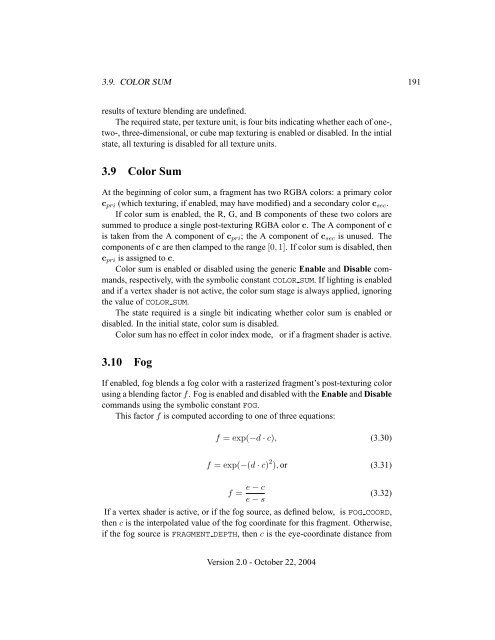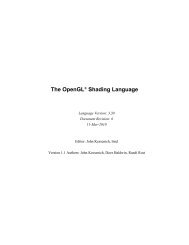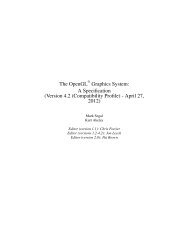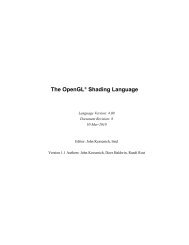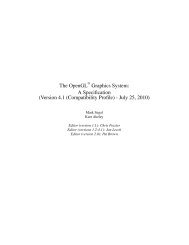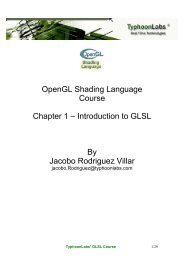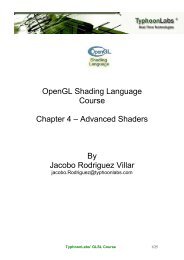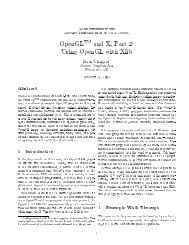- Page 1 and 2:
The OpenGL R○ Graphics System: A
- Page 3 and 4:
Contents 1 Introduction 1 1.1 Forma
- Page 5 and 6:
CONTENTS iii 3.5.7 Polygon Rasteriz
- Page 7 and 8:
CONTENTS v 6.1.14 Shader and Progra
- Page 9 and 10:
CONTENTS vii I Version 2.0 340 I.1
- Page 11 and 12:
List of Figures 2.1 Block diagram o
- Page 13 and 14:
LIST OF TABLES xi 3.15 Conversion f
- Page 15 and 16:
Chapter 1 Introduction This documen
- Page 17 and 18:
1.5. OUR VIEW 3 1.5 Our View We vie
- Page 19 and 20:
2.1. OPENGL FUNDAMENTALS 5 general,
- Page 21 and 22:
2.3. GL COMMAND SYNTAX 7 client sta
- Page 23 and 24:
2.3. GL COMMAND SYNTAX 9 GL Type Mi
- Page 25 and 26:
2.5. GL ERRORS 11 back from the fra
- Page 27 and 28:
2.6. BEGIN/END PARADIGM 13 Each ver
- Page 29 and 30:
2.6. BEGIN/END PARADIGM 15 Processe
- Page 31 and 32:
2.6. BEGIN/END PARADIGM 17 2 1 3 4
- Page 33 and 34:
2.6. BEGIN/END PARADIGM 19 2.6.2 Po
- Page 35 and 36:
2.7. VERTEX SPECIFICATION 21 take t
- Page 37 and 38:
2.8. VERTEX ARRAYS 23 MAX VERTEX AT
- Page 39 and 40:
2.8. VERTEX ARRAYS 25 Command Sizes
- Page 41 and 42:
2.8. VERTEX ARRAYS 27 Specifying an
- Page 43 and 44:
2.8. VERTEX ARRAYS 29 enabled. Curr
- Page 45 and 46:
2.8. VERTEX ARRAYS 31 void Interlea
- Page 47 and 48:
2.9. BUFFER OBJECTS 33 } DisableCli
- Page 49 and 50:
2.9. BUFFER OBJECTS 35 void BufferD
- Page 51 and 52:
2.9. BUFFER OBJECTS 37 Name Value B
- Page 53 and 54:
2.10. RECTANGLES 39 2.9.2 Array Ind
- Page 55 and 56:
2.11. COORDINATE TRANSFORMATIONS 41
- Page 57 and 58:
2.11. COORDINATE TRANSFORMATIONS 43
- Page 59 and 60:
2.11. COORDINATE TRANSFORMATIONS 45
- Page 61 and 62:
2.11. COORDINATE TRANSFORMATIONS 47
- Page 63 and 64:
2.11. COORDINATE TRANSFORMATIONS 49
- Page 65 and 66:
2.11. COORDINATE TRANSFORMATIONS 51
- Page 67 and 68:
2.12. CLIPPING 53 undefined. The us
- Page 69 and 70:
2.13. CURRENT RASTER POSITION 55 is
- Page 71 and 72:
2.14. COLORS AND COLORING 57 raster
- Page 73 and 74:
2.14. COLORS AND COLORING 59 GL Typ
- Page 75 and 76:
2.14. COLORS AND COLORING 61 Parame
- Page 77 and 78:
2.14. COLORS AND COLORING 63 The va
- Page 79 and 80:
2.14. COLORS AND COLORING 65 Parame
- Page 81 and 82:
2.14. COLORS AND COLORING 67 Curren
- Page 83 and 84:
2.14. COLORS AND COLORING 69 The fi
- Page 85 and 86:
2.15. VERTEX SHADERS 71 2.14.9 Fina
- Page 87 and 88:
2.15. VERTEX SHADERS 73 The strings
- Page 89 and 90:
2.15. VERTEX SHADERS 75 void UsePro
- Page 91 and 92:
2.15. VERTEX SHADERS 77 have been l
- Page 93 and 94:
2.15. VERTEX SHADERS 79 Uniform Var
- Page 95 and 96:
2.15. VERTEX SHADERS 81 FLOAT VEC2,
- Page 97 and 98:
2.15. VERTEX SHADERS 83 image unit
- Page 99 and 100:
2.15. VERTEX SHADERS 85 • Clippin
- Page 101 and 102:
2.15. VERTEX SHADERS 87 it cannot b
- Page 103 and 104:
2.15. VERTEX SHADERS 89 • A boole
- Page 105 and 106:
From Primitive Assembly DrawPixels
- Page 107 and 108:
3.2. ANTIALIASING 93 uniform intens
- Page 109 and 110:
3.3. POINTS 95 exact positions, rat
- Page 111 and 112:
3.3. POINTS 97 3.3.1 Basic Point Ra
- Page 113 and 114:
3.3. POINTS 99 6.0 5.0 4.0 3.0 2.0
- Page 115 and 116:
3.4. LINE SEGMENTS 101 the fragment
- Page 117 and 118:
3.4. LINE SEGMENTS 103 © © © ©
- Page 119 and 120:
3.4. LINE SEGMENTS 105 factor is cl
- Page 121 and 122:
3.4. LINE SEGMENTS 107 Figure 3.6.
- Page 123 and 124:
3.5. POLYGONS 109 CULL FACE. Front
- Page 125 and 126:
3.5. POLYGONS 111 Polygon stippling
- Page 127 and 128:
3.5. POLYGONS 113 Boolean state val
- Page 129 and 130:
3.6. PIXEL RECTANGLES 115 Parameter
- Page 131 and 132:
3.6. PIXEL RECTANGLES 117 Parameter
- Page 133 and 134:
3.6. PIXEL RECTANGLES 119 Table Nam
- Page 135 and 136:
3.6. PIXEL RECTANGLES 121 RGBA, wit
- Page 137 and 138:
3.6. PIXEL RECTANGLES 123 Special f
- Page 139 and 140:
3.6. PIXEL RECTANGLES 125 void Hist
- Page 141 and 142:
3.6. PIXEL RECTANGLES 127 byte, sho
- Page 143 and 144:
3.6. PIXEL RECTANGLES 129 Format Na
- Page 145 and 146:
3.6. PIXEL RECTANGLES 131 SKIP_PIXE
- Page 147 and 148:
3.6. PIXEL RECTANGLES 133 UNSIGNED
- Page 149 and 150:
3.6. PIXEL RECTANGLES 135 Format Fi
- Page 151 and 152:
3.6. PIXEL RECTANGLES 137 Stencil i
- Page 153 and 154: 3.6. PIXEL RECTANGLES 139 Color Ind
- Page 155 and 156: 3.6. PIXEL RECTANGLES 141 Base Filt
- Page 157 and 158: 3.6. PIXEL RECTANGLES 143 the RGBA
- Page 159 and 160: 3.6. PIXEL RECTANGLES 145 POST CONV
- Page 161 and 162: 3.7. BITMAPS 147 group component va
- Page 163 and 164: 3.8. TEXTURING 149 and upper right
- Page 165 and 166: 3.8. TEXTURING 151 The mechanism fo
- Page 167 and 168: 3.8. TEXTURING 153 Base Internal Fo
- Page 169 and 170: 3.8. TEXTURING 155 Compressed Inter
- Page 171 and 172: 3.8. TEXTURING 157 two-dimensional
- Page 173 and 174: 3.8. TEXTURING 159 3.8.2 Alternate
- Page 175 and 176: 3.8. TEXTURING 161 ture array that
- Page 177 and 178: 3.8. TEXTURING 163 Counting from ze
- Page 179 and 180: 3.8. TEXTURING 165 void CompressedT
- Page 181 and 182: 3.8. TEXTURING 167 Name Type Legal
- Page 183 and 184: 3.8. TEXTURING 169 Using the sc, tc
- Page 185 and 186: 3.8. TEXTURING 171 mapping to frame
- Page 187 and 188: 3.8. TEXTURING 173 TEXTURE MIN FILT
- Page 189 and 190: 3.8. TEXTURING 175 Mipmapping TEXTU
- Page 191 and 192: 3.8. TEXTURING 177 Finally, there i
- Page 193 and 194: 3.8. TEXTURING 179 level of detail,
- Page 195 and 196: 3.8. TEXTURING 181 initial textures
- Page 197 and 198: 3.8. TEXTURING 183 When target is P
- Page 199 and 200: 3.8. TEXTURING 185 Texture Base BLE
- Page 201 and 202: 3.8. TEXTURING 187 SRCn RGB OPERAND
- Page 203: 3.8. TEXTURING 189 If the value of
- Page 207 and 208: 3.11. FRAGMENT SHADERS 193 a color
- Page 209 and 210: 3.11. FRAGMENT SHADERS 195 The GL r
- Page 211 and 212: 3.12. ANTIALIASING APPLICATION 197
- Page 213 and 214: 4.1. PER-FRAGMENT OPERATIONS 199 Fr
- Page 215 and 216: 4.1. PER-FRAGMENT OPERATIONS 201 do
- Page 217 and 218: 4.1. PER-FRAGMENT OPERATIONS 203 ma
- Page 219 and 220: 4.1. PER-FRAGMENT OPERATIONS 205 If
- Page 221 and 222: 4.1. PER-FRAGMENT OPERATIONS 207 Mo
- Page 223 and 224: 4.1. PER-FRAGMENT OPERATIONS 209 Bl
- Page 225 and 226: 4.1. PER-FRAGMENT OPERATIONS 211 Ar
- Page 227 and 228: 4.2. WHOLE FRAMEBUFFER OPERATIONS 2
- Page 229 and 230: 4.2. WHOLE FRAMEBUFFER OPERATIONS 2
- Page 231 and 232: 4.2. WHOLE FRAMEBUFFER OPERATIONS 2
- Page 233 and 234: 4.3. DRAWING, READING, AND COPYING
- Page 235 and 236: 4.3. DRAWING, READING, AND COPYING
- Page 237 and 238: 4.3. DRAWING, READING, AND COPYING
- Page 239 and 240: 4.3. DRAWING, READING, AND COPYING
- Page 241 and 242: Chapter 5 Special Functions This ch
- Page 243 and 244: 5.1. EVALUATORS 229 EvalMesh EvalPo
- Page 245 and 246: 5.1. EVALUATORS 231 This is done us
- Page 247 and 248: 5.2. SELECTION 233 EvalCoord2(p *
- Page 249 and 250: 5.3. FEEDBACK 235 written. The mini
- Page 251 and 252: 5.4. DISPLAY LISTS 237 Type coordin
- Page 253 and 254: 5.4. DISPLAY LISTS 239 state. When
- Page 255 and 256:
5.4. DISPLAY LISTS 241 the effect o
- Page 257 and 258:
5.6. HINTS 243 Target Hint descript
- Page 259 and 260:
6.1. QUERYING GL STATE 245 6.1.2 Da
- Page 261 and 262:
6.1. QUERYING GL STATE 247 TEXTURE
- Page 263 and 264:
6.1. QUERYING GL STATE 249 Base Int
- Page 265 and 266:
6.1. QUERYING GL STATE 251 are used
- Page 267 and 268:
6.1. QUERYING GL STATE 253 target m
- Page 269 and 270:
6.1. QUERYING GL STATE 255 of bits
- Page 271 and 272:
6.1. QUERYING GL STATE 257 returns
- Page 273 and 274:
6.1. QUERYING GL STATE 259 into sou
- Page 275 and 276:
6.1. QUERYING GL STATE 261 table 6.
- Page 277 and 278:
6.1. QUERYING GL STATE 263 Type cod
- Page 279 and 280:
6.2. STATE TABLES 265 Get Initial G
- Page 281 and 282:
6.2. STATE TABLES 267 Initial Value
- Page 283 and 284:
6.2. STATE TABLES 269 Get Initial G
- Page 285 and 286:
6.2. STATE TABLES 271 Get Initial G
- Page 287 and 288:
6.2. STATE TABLES 273 Get Initial G
- Page 289 and 290:
6.2. STATE TABLES 275 Get Initial G
- Page 291 and 292:
6.2. STATE TABLES 277 Get Initial G
- Page 293 and 294:
6.2. STATE TABLES 279 Get Initial G
- Page 295 and 296:
6.2. STATE TABLES 281 Get Initial G
- Page 297 and 298:
6.2. STATE TABLES 283 Get Initial G
- Page 299 and 300:
6.2. STATE TABLES 285 Get Initial G
- Page 301 and 302:
6.2. STATE TABLES 287 Get Initial G
- Page 303 and 304:
6.2. STATE TABLES 289 Initial Value
- Page 305 and 306:
6.2. STATE TABLES 291 Get Initial G
- Page 307 and 308:
6.2. STATE TABLES 293 Minimum Value
- Page 309 and 310:
6.2. STATE TABLES 295 Minimum Value
- Page 311 and 312:
6.2. STATE TABLES 297 Initial Value
- Page 313 and 314:
Appendix A Invariance The OpenGL sp
- Page 315 and 316:
A.3. INVARIANCE RULES 301 • Sciss
- Page 317 and 318:
Appendix B Corollaries The followin
- Page 319 and 320:
305 17. (No pixel dropouts or dupli
- Page 321 and 322:
C.2. POLYGON OFFSET 307 C.2 Polygon
- Page 323 and 324:
C.10. ACKNOWLEDGEMENTS 309 3. The l
- Page 325 and 326:
Appendix D Version 1.2 OpenGL versi
- Page 327 and 328:
D.7. TEXTURE LEVEL OF DETAIL CONTRO
- Page 329 and 330:
D.10. ACKNOWLEDGEMENTS 315 D.9.4 Pi
- Page 331 and 332:
D.10. ACKNOWLEDGEMENTS 317 Phil Lac
- Page 333 and 334:
Appendix E Version 1.2.1 OpenGL ver
- Page 335 and 336:
F.3. MULTISAMPLE 321 one cube face
- Page 337 and 338:
F.9. TRANSPOSE MATRIX 323 image, th
- Page 339 and 340:
F.10. ACKNOWLEDGEMENTS 325 Elio Del
- Page 341 and 342:
F.10. ACKNOWLEDGEMENTS 327 Tim Kell
- Page 343 and 344:
G.3. CHANGES TO THE IMAGING SUBSET
- Page 345 and 346:
G.12. TEXTURE LOD BIAS 331 Texture
- Page 347 and 348:
G.15. ACKNOWLEDGEMENTS 333 John Sta
- Page 349 and 350:
H.2. OCCLUSION QUERIES 335 H.2 Occl
- Page 351 and 352:
H.5. ACKNOWLEDGEMENTS 337 Paul Carm
- Page 353 and 354:
H.5. ACKNOWLEDGEMENTS 339 Neil Trev
- Page 355 and 356:
I.2. MULTIPLE RENDER TARGETS 341 I.
- Page 357 and 358:
I.7. ACKNOWLEDGEMENTS 343 After the
- Page 359 and 360:
Appendix J ARB Extensions OpenGL ex
- Page 361 and 362:
J.7. CUBE MAP TEXTURES 347 J.7 Cube
- Page 363 and 364:
J.20. WINDOW RASTER POSITION 349 J.
- Page 365 and 366:
J.32. MULTIPLE RENDER TARGETS 351 J
- Page 367 and 368:
INDEX 353 ArrayElement, 19, 27-29,
- Page 369 and 370:
INDEX 355 CopyConvolutionFilter2D,
- Page 371 and 372:
INDEX 357 FOG COORD ARRAY STRIDE, 3
- Page 373 and 374:
INDEX 359 Index[type]v, 27 INDEX AR
- Page 375 and 376:
INDEX 361 85 MAX VERTEX UNIFORM COM
- Page 377 and 378:
INDEX 363 POST CONVOLUTION GREEN SC
- Page 379 and 380:
INDEX 365 STATIC READ, 34, 35 STENC
- Page 381 and 382:
INDEX 367 UniformMatrix*, 343 Unifo


